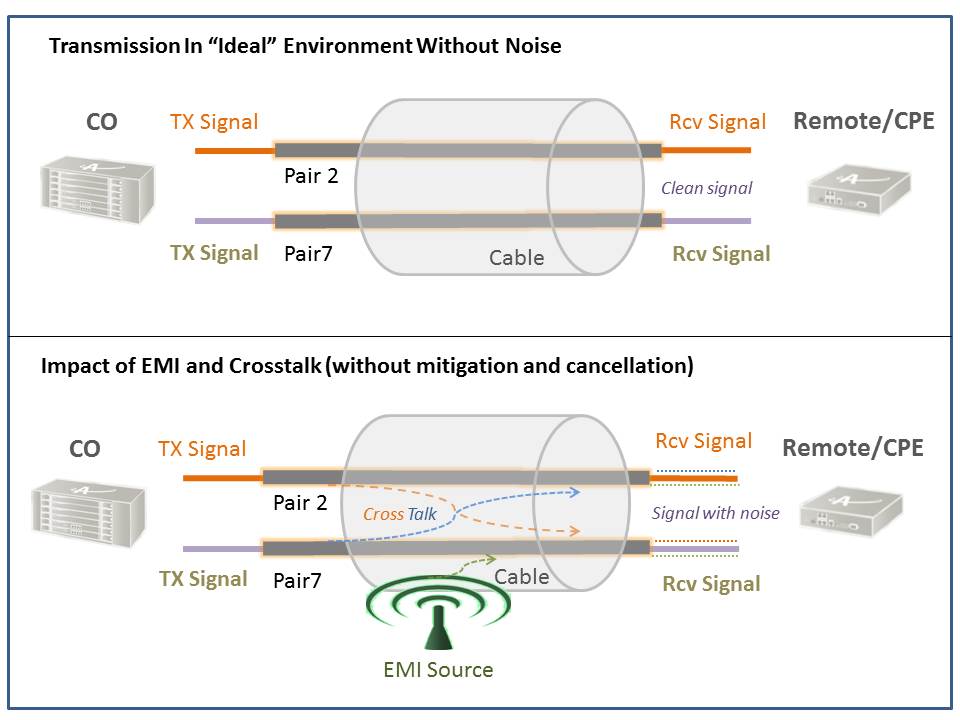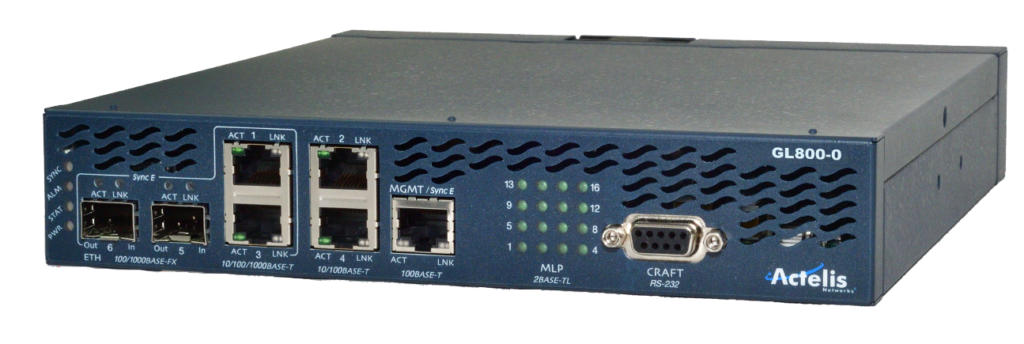Making Broadband Over Copper Reliable, High Performance Transport
Cross Talk is the one of the main limiting factors that impacts the performance of the existing copper cable plant. Managing crosstalk effectively and dynamically can significantly enhance the reliability of the link and the performance of the services riding over it, and makes copper suitable for longer transmission distances to enable service operators to reach more customers.
Actelis Networks’ broadband over copper solutions, incorporate sophisticated algorithms and techniques that can effectively identify and mitigate electromagnetic interference (EMI) and cross-talk. Doing so makes transmission over copper carrier class, dramatically increasing the Signal to Noise Ratio (SNR), reliability, user QoE and revenue opportunities of services delivered over copper. Although G.SHDSL and DMT (VDSL2 bonding) are standards-based, the expertise and techniques required to eliminate noise and ensure high performance transmission over copper goes beyond the standards and is Actelis’ core competence.
Key terms operators need to understand
- EMI Electromagnetic interference (EMI) occurs when electrical signals from the local environment outside of the binder are picked up by the copper pairs in a cable and introduce noise. This can reduce the Signal to Noise Ratio (SNR), which if left unchecked can reduce the distance and transmission rates of copper.
- Crosstalk – Crosstalk occurs when a signal transmitted on one copper twisted pair in a bundle radiates and potentially interferes with and degrades the transmission on another pair. Left unchecked, this can reduce the signal to noise ratio (SNR), and historically was a limiting factor to transmission over copper.

Where does crosstalk occur? Crosstalk can and will typically happen between pairs/services within the same copper cable or binder. Cross talk is strongest within the same binder, and depends on the placement and proximity of pairs. It can also be strong between binders – but tends to be negligible between cables.
Where On The Link Is Cross Talk Generated? –Most cross talk is generated at both ends of the link, i.e. at the CO and at the CPE/NTU side. The amount of Crosstalk generated is inversely proportional to the distance between the pairs within the binder/cable.
What kinds of noise could potentially impact a G.SHDSL transmitted signal? Electromagnetic Interference (EMI), Near End Crosstalk (NEXT), and Far End Crosstalk (FEXT). G.SHDSL bonded copper solutions are potentially be impacted most by NEXT if it is not overcome. DMT bonded copper (VDSL2 bonded copper) is potentially impacted most by FEXT, so overcoming this is most important to ensuring top performance.
- External Noise: External Noise can be for example – thermal, EMI, AC radiation, radio signals, motors, fluorescent lights, rectifiers, etc. that can created performance degradation of the signal
- NEXT (Near End Crosstalk): Next is generated by disturbing signals emanating from other transmitters at the same end of the loop, near the victim receiver. Next is measured at the same end from which the disturbing signal is transmitted. NEXT can highly impact G.SHDSL based technologies.
- FEXT (Far End Cross Talk); FEXT is generated by disturbing transmitters at the opposite end of the loop, FAR from the victim receiver. FEXT is measured at the other end of the cable furthest from the transmitter. FEXT can highly impact DMT, i.e. VDSL2/ADSL2+/ADSL2/ADSL based technologies.
Mitigating Noise
Actelis Networks has a core competence in profiling and understanding various types of noise and building in the capability to recognize, identify, prioritize mitigation, and near end crosstalk (NEXT), far end crosstalk (FEXT), and electromagnetic interference. Our expertise in creating unique algorithms and technology to identify the sources and nature of noise and mitigate multiple sources of noise in real-time assures the highest Signal to Noise Ratio (SNR), best link reliability, and highest transmission rates possible to enable service operators to offer G.SHDSL and VDSL2 bonded links over greater distances to reach more customers with more bandwidth.
Actelis’ EFMplus™ suite of transmission techniques gives service operators an important advantage in the access toolkit, because once crosstalk can be overcome, copper becomes a reliable, high performance access media viable that is the quickest, easiest, and most cost effective way to take 100s of Mbps of high performance bandwidth wherever it is needed throughout the metro. With EMI, NEXT, and FEXT tamed, copper becomes a strategic asset that enables operators to cash in on new customers, Ethernet services for small cell and Wii backhaul, Business Ethernet and Cloud service revenues to SMEs, mini DSLAM backhaul and residential broadband, as well as enabling bundling and wholesaling of third party’s value added services. All at minimum cost and maximum profitability.
Related Broadband Solutions
GigaLine 800
Get multi-gig connectivity to apartments, office buildings, hotels, and more with the GL800. Immediately extend your fiber connection over existing wiring for instant broadband connectivity.
GigaLine 900
Our cost effective, ultra-low power Gigabit Ethernet PON splitter extender is the perfect solution for MDUs. Instantly extend Gigabit connectivity throughout the building utilizing your existing coax or twisted pair.



